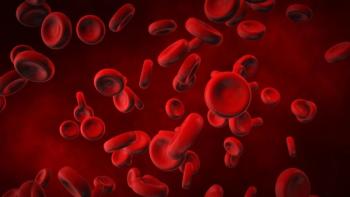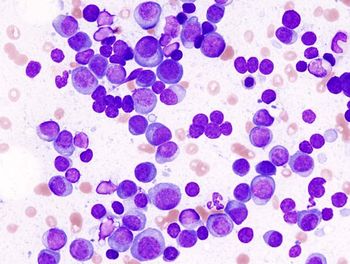
Oncology NEWS International
- Oncology NEWS International Vol 5 No 3
- Volume 5
- Issue 3
Dose-Intense Chemo in Breast Ca Questioned
PARIS--Although well over 1,000 patients with breast cancer are now registered with the North American Autologous Bone Marrow Transplant Registry each year, it is still unclear whether these women actually have something to gain in the long run from dose-intensified regimens, Dr. Gabriel Hortobagyi, of M.D. Anderson Cancer Center, said at the Sixth International Congress on Anti-Cancer Treatment (ICACT).
PARIS--Although well over 1,000 patients with breast cancer arenow registered with the North American Autologous Bone MarrowTransplant Registry each year, it is still unclear whether thesewomen actually have something to gain in the long run from dose-intensifiedregimens, Dr. Gabriel Hortobagyi, of M.D. Anderson Cancer Center,said at the Sixth International Congress on Anti-Cancer Treatment(ICACT).
"Although preliminary results are encouraging," Dr.Hortobagyi said, "there is insufficient evidence to showthat high-dose chemotherapy is better than standard-dose chemotherapyfor either metastatic or high-risk primary breast cancer."
While acknowledging that there are strong and compelling reasonsto believe that dose-intensive chemotherapy correlates with improvedresponse rates and cure rates, Dr. Hortobagyi said that this doesnot hold true for all cytotoxic drugs.
For example, he noted, the difference between high-dose and low-dose5-fluorouracil is much more modest than the difference betweenhigh-dose and low-dose doxorubicin. "For many drugs, doseintensity might be an important consideration, but for othersit is irrelevant to clinical treatment," he said.
High-dose regimens yield complete response rates on the orderof 50% in metastatic breast cancer, but these responses tend tobe short-lived, with only about 15% to 20% of women remainingfree of disease after 3 to 4 years.
"There may be a small minority of women who do derive long-termbenefit," Dr. Hortobagyi said. "The question is, whatis the real fraction of patients that benefit, and is this comparableto standard chemotherapy?"
Dr. Hortobagyi pointed out that most trials of high-dose chemotherapyhave restricted enrollment to women under the age of 62 with highperformance status and limited comorbidity. He explained thatthe age requirement alone will disqualify half of women with metastaticbreast cancer while the other exclusion criteria will leave nomore than a third of patients eligible.
When he and his colleagues applied these selection criteria retrospectivelyto a large database generated at M.D. Anderson, they found thatthe time to disease progression was longer in those women whowould have been considered eligible for high-dose chemotherapythan in those who would have been deemed ineligible.
"So the trial selection process selects patients with a goodprognosis, which complicates the assessment," he said. "Didthey do better because the treatment was better, or did they dobetter because of the selection?"
In a review of trials of standard-dose doxorubicin-containingregimens, Dr. Hortobagyi found 2-year survival rates ranging from32% (for randomized studies) to 41% (for nonrandomized studies).These compared favorably with the results of high-dose chemotherapytrials, he said, notwithstanding the substantially higher responserates reported with dose-intense treatment.
He also cited Eddy's analysis showing that although response ratesof patients with metastatic breast cancer were 30% higher withhigh-dose chemotherapy than with standard chemotherapy, this differencedid not translate into a longer duration of response or longersurvival.
Recent Trial Results Questioned
Dr. Hortobagyi also questioned the findings of two recent randomizedtrials that compared standard-dose chemotherapy with high-dosechemotherapy. Although a South African study revealed a highlysignificant survival advantage for high-dose chemotherapy, Dr.Hortobagyi stressed that patients treated with low-dose therapyin this trial fared considerably worse than would be expected.
A second trial from Duke University compared early high-dose chemotherapyin patients who were in complete remission following standard-doseinduction chemotherapy with late high-dose chemotherapy in womenwho had relapsed following a complete response to induction chemotherapy.
"This is a very puzzling study, and I'm not sure how to interpretit," Dr. Hortobagyi said. In this study, median disease-freesurvival was 20 months with early high-dose therapy and 4 monthswith late high-dose therapy; however, patients who received lateintensification lived twice as long as those who were intensifiedearly.
Role as Adjuvant Treatment
The value of high-dose chemotherapy in the adjuvant treatmentof high-risk primary breast cancer also remains open to question,he said. Although CALGB found a substantial survival differenceat 3 years in favor of high-dose chemotherapy in women with node-positivedisease, most of this difference was restricted to the subgroupthat had tumors overexpressing the HER2 oncogene.
"It is difficult to state that high-dose chemotherapy isbetter for all because it might just be better for HER2-neu overexpressers,"Dr. Hortobagyi said.
Another key question that must be studied is whether there mightbe a minimum threshold dose that must be administered in orderto achieve benefit, but above which no incremental advantage isgained.
Variable Results
Dr. Hortobagyi acknowledged that considerable enthusiasm for high-dosechemotherapy has been aroused by a Duke University study showing70% 5-year disease-free survival in women with at least 10 positivenodes, and by reports from Milan of 93% and 56% relapse-free survivalat 2 years and 5 years, respectively. However, he said, the literatureshows that, after surgery alone, 2-year relapse-free survivalvaries from 11% to 70%, and 5-year relapse-free survival variesfrom 11% to 51% in unselected patients.
Likewise, reported rates of 5-year disease-free survival followingstandard chemotherapy have ranged from 11% to 60%. "You willfind substantial variability in response to standard chemotherapy,"Dr. Hortobagyi said, "and, in fact, the difference betweenthe highest and lowest survival rates following standard chemotherapyis greater than the difference between the best standard chemotherapyand high-dose chemotherapy."
Moreover, he said, as in metastatic breast cancer, the selectioncriteria employed in trials of high-dose adjuvant chemotherapytend to exclude those patients with poorer prognoses.
"The absence of proof does not mean the absence of benefit,"Dr. Hortobagyi said. Nonetheless, he urged clinicians to be verycareful about what they recommend to their patients.
"We know that there is a linear correlation between doseintensity and survival for some parts of the dose intensity curve,but what we don't know is whether that linear correlation appliesto the entire spectrum of doses, to all patients, and for alldrugs," he said. "Until we prove that benefit exists,I think we are obligated to treat patients who want dose intensificationonly in clinical trials."
Articles in this issue
almost 30 years ago
Drug Allows Higher Doxorubicin Doses in Breast Ca Patientsalmost 30 years ago
Nori Appointed to Cornell Department of Radiation Oncologyalmost 30 years ago
Academic Centers Must Change or Perish in Climate of Managed Carealmost 30 years ago
Genetically Altered Hematopoietic Cells Used in Transplant Researchalmost 30 years ago
Bill Would Ease Distribution of Off-Label Dataalmost 30 years ago
New Drug Combinations May Improve Outlook in AIDS Patientsalmost 30 years ago
Final Word on Diet-Breast Cancer Link Must Come From Clinical Trials: WHIalmost 30 years ago
LHRH Agonist Matches Ovariectomy Results: SWOGalmost 30 years ago
Schacter Named Clinical Trials Director at YaleNewsletter
Stay up to date on recent advances in the multidisciplinary approach to cancer.

















































































